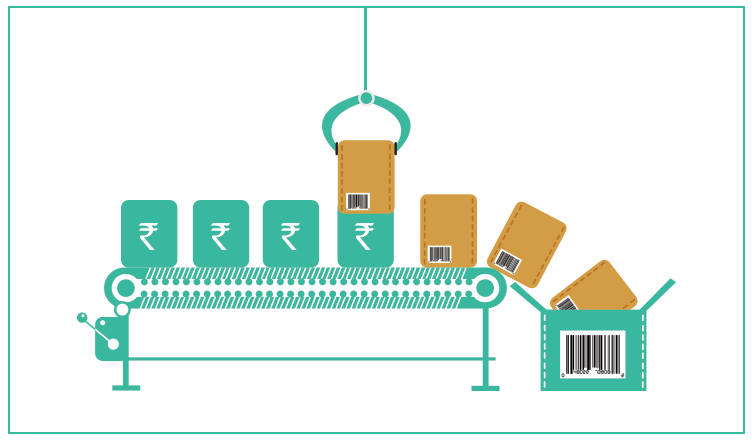Gross profit is the profit booked on sales of goods. You can deduct the cost of goods sold from net sales to find gross profit.
Accounting involves numerous terminologies, each with its own significance. When it comes to profitability, we usually refer to net profit frequently. However, there is another type of profit that is equally important in the same context. It is known as “gross profit.” You might have encountered gross profit while looking at the accounts of any business enterprise. However, do you know what it is and how it differs from net profit? Let us understand gross profit meaning, its importance, and how to calculate gross profit. Let us also touch upon the meaning and significance of gross profit margin.
What is Gross Profit?
Also known as gross margin, gross profit is the profit derived from the goods sold. While calculating gross profit, you have to ignore all the indirect expenses. The following is the gross profit formula that will bring out a clear picture:
Gross profit = Total sales – total cost of goods sold
The above formula can be further expanded as follows:
Gross profit = (Sales + Closing Stock) – (Opening Stock + Purchases + Direct Costs)
When you are preparing final accounts, you typically derive gross profit as the balancing figure of the trading account, which is then carried forward to the profit and loss account to calculate the net profitability.
Gross profit shows the profit your business makes from selling the goods before adjusting for indirect expenses. Indirect expenses typically include administrative expenses, selling and distribution fees, etc.
What is the Cost of Goods Sold?
The cost of goods sold typically includes all costs necessary to sell your goods. For instance, purchases, direct wages, direct materials, and overheads are part of your cost of goods sold. These costs usually vary according to the number of goods sold. The more your goods are sold, the higher your cost of goods sold.
Gross Profit Margin (GPM)
While the gross profit is an absolute figure, it is essential to denote it in relative terms (in percentage) to arrive at a meaningful conclusion. Gross profit margin (GPM) measures how much margin business owners earn on their sales. The gross profit margin formula is as follows:
Gross profit margin = (Gross profit / Net Revenue) * 100
Where,
Net revenue = total sales – returns.
The above gross margin formula shows you the ratio of the gross profit to the net sales. The higher the gross profit margin, the higher the profit the business is booking from its goods.
The Importance of Gross Profit and Gross Profit Margin
While you might be clear with gross profit and gross margin meaning, it is vital to understand their role and importance. Gross profit shows the amount that is available for meeting the indirect expenses of your business.
This typically includes fixed costs such as rent, salaries, electricity, maintenance, repairs, interest, etc. These costs are not directly incurred for your sales but are necessary for operating your business.
You need to ensure that you book enough gross profit to meet your indirect costs and earn a net profit. The gross profit margin acts as a benchmark that shows whether you are booking enough profits or not.
While the gross profit amount can increase or decrease depending upon your business turnover, you should strive to maintain the gross profit margin ratio. Therefore, the gross profit margin is an important profitability ratio, and financial experts use it to determine the profitability of a business.
Practical Illustration to Determine Gross Profit and Gross Profit Margin
Suppose Mr. A is running a trading business. The following are the figures he presented at the close of the financial year:
- Opening stock: Rs. 1,40,000
- Purchases: Rs. 4,95,000
- Sales: Rs. 7,46,000
- Closing stock: Rs. 1,72,000
- Direct wages: Rs. 95,000
Therefore, by applying the gross profit formula and the profit margin formula:
| Gross Profit | Gross Profit Margin |
| (7,46,000 + 1,72,000) – (1,40,000 + 4,95,000 + 95,000)= Rs. 1,88,000 | Rs. 1,88,000 / Rs. 7,46,000= 25.20% |
In a Nutshell
Gross profit and gross profit margin are both critical to determine whether your business earns adequately to meet its operational and administrative costs. Further, you should either strive to maintain the gross profit margin ratio or increase it to increase your profitability.
However, it is important to increase profits to receive timely customer payments. PayU allows you to easily collect online and offline payments, allowing businesses to accept payments on time and maximise profitability.
Also read: 7 Quick Steps of Product Pricing
Frequently Asked Questions
Gross profit is calculated if goods are involved. Therefore, gross profit cannot be calculated if the service industry does not include goods.
Yes. In rare situations, it can happen that even though gross profit is negative, the net profit still turns out to be positive. For instance, in the case of the sale of a major asset at a value higher than its current book value, the net profit can turn out to be positive even though the business has reported a negative gross profit or gross loss.
Secondly, if the business has a huge indirect income, net profit can be positive despite the gross loss.
To increase the gross profits for your business, you can do the following:
Increase the sale price of your goods
Decrease the purchase price of your goods
Eliminate unnecessary direct costs from your business





